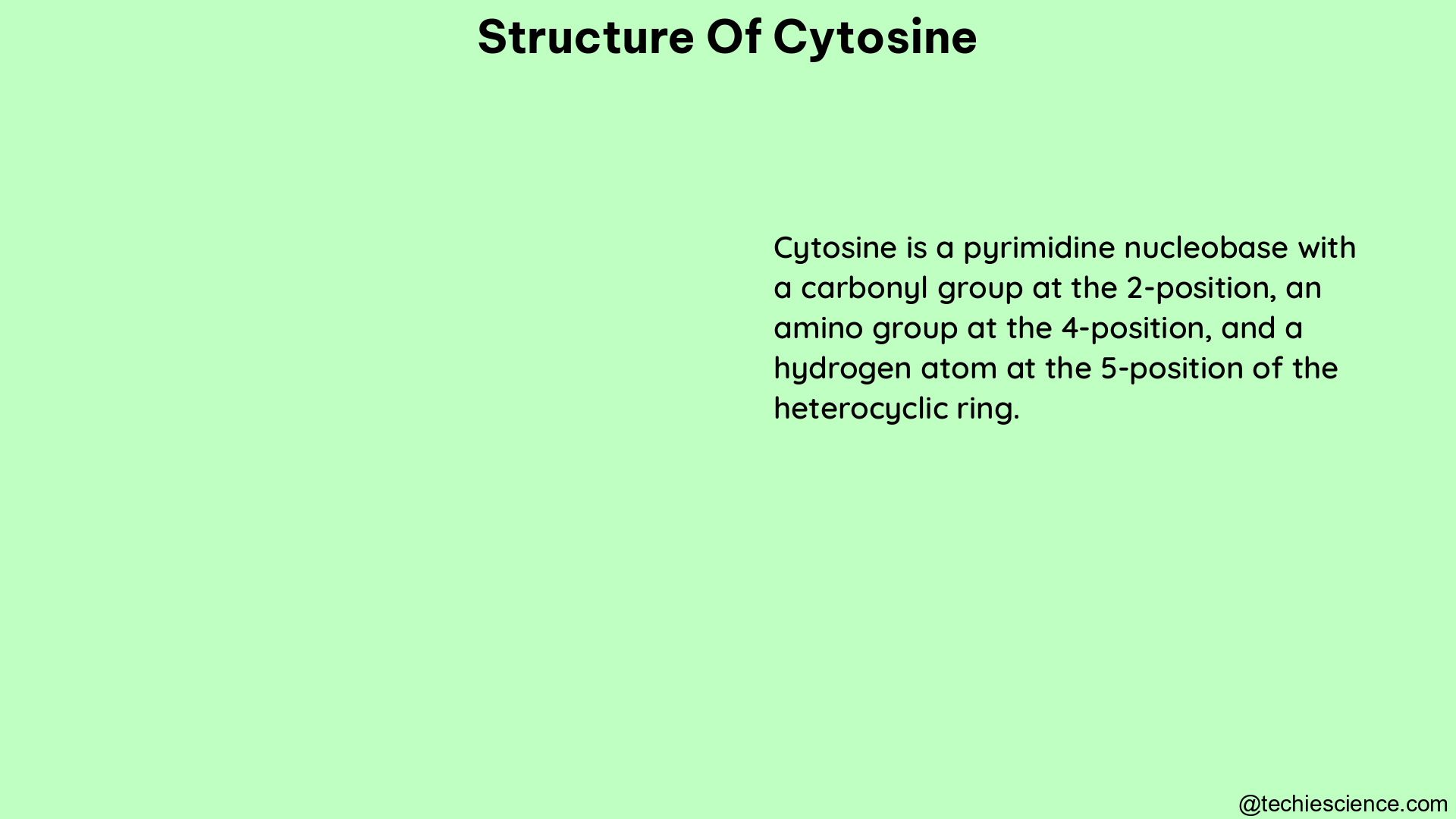Cytosine, a fundamental nucleobase found in both DNA and RNA, has a well-defined and extensively studied structure. As a pyrimidine derivative, cytosine consists of a six-membered ring with two nitrogen atoms and four carbon atoms. Its molecular weight is approximately 111.12 g/mol, and it contains an amino group (-NH2) attached to the C4 carbon atom and a carbonyl group (-C=O) attached to the C2 carbon atom.
The Hydrogen Bonding Capabilities of Cytosine
Cytosine is a polar molecule, which allows it to form hydrogen bonds with other nucleobases. Specifically, cytosine forms two hydrogen bonds with guanine, its complementary base in DNA. The bond length between the N1 nitrogen atom in cytosine and the N3 nitrogen atom in guanine is approximately 0.29 nm, while the bond length between the O2 oxygen atom in cytosine and the N1 nitrogen atom in guanine is approximately 0.28 nm.
Cytosine Modifications: Expanding the Structural Diversity

Cytosine can undergo various chemical modifications, which can alter its structure and chemical properties. These modifications include:
Methylation
The methylation of cytosine at the C5 carbon atom results in the formation of 5-methylcytosine. This modification has been linked to diverse biological processes and disease states. The molecular weight of 5-methylcytosine is approximately 125.14 g/mol, which is slightly higher than that of cytosine due to the addition of a methyl group (-CH3).
Hydroxymethylation
Another modification is hydroxymethylation, which leads to the formation of 5-hydroxymethylcytosine. This modification is involved in the cytosine demethylation pathway and may have distinct biological roles. The molecular weight of 5-hydroxymethylcytosine is approximately 139.16 g/mol, which is higher than that of cytosine due to the addition of a hydroxymethyl group (-CH2OH).
Formylation and Carboxylation
In addition to methylation and hydroxymethylation, cytosine can also undergo formylation and carboxylation modifications. These modifications can further diversify the structural and chemical properties of cytosine, potentially impacting its biological functions.
Affinity Tagging of Cytosine
Cytosine can be modified by the addition of affinity tags, such as biotin, which can enable the enrichment and isolation of DNA fragments containing the modification or modifications of interest. The incorporation of biotin tags can be achieved using enzymatic methods, such as those employed in the modular affinity-labeling approach.
Analytical Approaches for Cytosine Modification Analysis
The various modifications of cytosine can be quantified and analyzed using a range of analytical approaches, including:
-
Mass Spectrometry: This technique can provide precise quantification of cytosine modifications, such as methylation and hydroxymethylation, at the single-nucleotide level.
-
Quantitative PCR (qPCR): This method can be used to measure the relative abundance of specific cytosine modifications in DNA samples.
-
Sequencing: Advanced sequencing technologies, such as bisulfite sequencing and oxidative bisulfite sequencing, can map the distribution and patterns of cytosine modifications across the genome.
Biological Significance of Cytosine Modifications
The modifications of cytosine have been linked to diverse biological processes and disease states. For example, the methylation of cytosine has been associated with gene silencing, genomic imprinting, and the development of various cancers. The hydroxymethylation of cytosine, on the other hand, has been implicated in the cytosine demethylation pathway and may play a role in epigenetic regulation and cellular differentiation.
Conclusion
The structure of cytosine is a fundamental aspect of molecular biology, and its various modifications add to the complexity and diversity of this essential nucleobase. Understanding the intricate details of cytosine structure and its modifications is crucial for unraveling the underlying mechanisms of gene expression, epigenetic regulation, and disease pathogenesis. The analytical approaches discussed in this blog post provide valuable tools for researchers to explore the dynamic and multifaceted nature of cytosine in biological systems.
References:
– In situ Quantification of Cytosine Modification Levels in Human Cell Lines. NCBI. https://www.ncbi.nlm.nih.gov/pmc/articles/PMC10366683/
– Genome-Wide Discriminatory Information Patterns of Cytosine DNA Methylation. NCBI. https://www.ncbi.nlm.nih.gov/pmc/articles/PMC4926471/
– DNA Cytosine. ScienceDirect. https://www.sciencedirect.com/topics/chemistry/dna-cytosine
– Cytosine Derivative. ScienceDirect. https://www.sciencedirect.com/topics/pharmacology-toxicology-and-pharmaceutical-science/cytosine-derivative
– Modular affinity-labeling of the cytosine demethylation base excision repair pathway in DNA. Nature. https://www.nature.com/articles/s41598-020-76544-x
I am Ankita Chattopadhyay from Kharagpur. I have completed my B. Tech in Biotechnology from Amity University Kolkata. I am a Subject Matter Expert in Biotechnology. I have been keen in writing articles and also interested in Literature with having my writing published in a Biotech website and a book respectively. Along with these, I am also a Hodophile, a Cinephile and a foodie.